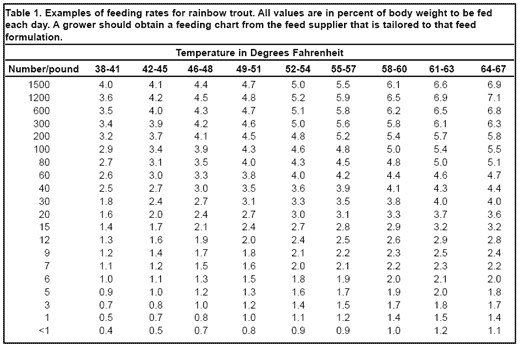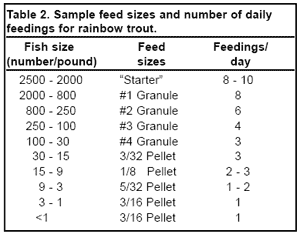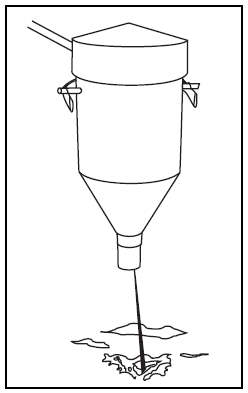Trout Production: Feeds and Feeding Methods
In trout farming, the amount and suitability of feed used determines the profitability of production. Trout and other salmonids can efficiently digest foods that contain primarily protein (mostly from fish), and can obtain some of their energy from fats and, to a lesser extent, from carbohydrates. Fry and fingerling trout require a higher protein and energy content in their diets than larger fish. Fry and fingerling feed should contain approximately 50 percent protein and 15 to 20 percent fat. Feeds for larger fish typically contain 38 to 45 percent protein and 10 to 18 percent fat. The switch to lower protein formulations usually occurs at the transition from a "crumble" feed to a pelleted ration, called a "growout" or "production" diet. High energy diets may contain 45 to 50 percent protein and 18 to 24 percent fat. Several brands of high quality commercial trout diets are available, and although a farm could produce its own fish food, it is not usually economical to do so.
Feed quality
Trout feeds have been greatly improved in the past decade. Fish meal is still the primary source of protein, but protein digestibility has been improved and ash content has been reduced by using fish meal processed at lower temperatures ("low-temp" fish meal). Also, diets now have higher energy levels that help fish use protein more efficiently.
Increasing the energy level in the diet limits the fish's use of protein as an energy source. Trout are being grown efficiently with dietary fat levels (mostly from fish oils) as high as 18 to 28 percent, provided the ratio of digestible protein to energy remains in the correct range. This ratio is expressed as grams digestible protein per megajoule of digestible energy.
Ask your feed manufacturer to tell you the ratio of protein to energy in your fish feed, especially if you plan to use high energy diets. For typical high energy diets the ratio should be about 20:1. Feeds with ratios significantly higher than 20 may contain excess protein or large amounts of protein that trout can not digest easily. Feeds with lower ratios may contain excess fat, and could affect flesh quality and dress-out percentages. However, specific diet formulations may vary considerably from this ratio and still be highly efficient if properly formulated.
Feeding practices
Trout producers usually try to grow the fish as quickly and efficiently as possible while maintaining uniformity of growth and degrading water quality as little as possible. To accomplish these goals it is important to feed the correct amount. The amount of feed trout require depends on water temperature and fish size. Smaller fish have faster metabolic rates and need more feed relative to their body weight than do larger fish. Because fish are poikilothermic (cold-blooded), their body temperatures and metabolic rates vary with water temperature. Fish in warmer water need more feed than fish in cooler water.
The minimum temperature for growth in trout is about 38ºF. At this temperature and below, appetites are suppressed, digestive systems operate very slowly, and trout require only a maintenance diet (0.5 to 1.8 percent of body weight per day, depending upon fish size). Feeding more than this wastes feed.
In warm water (above 68ºF), a trout's digestive system does not use nutrients well and more of the consumed feed is only partially digested before being eliminated. This nutrient loading of the water, coupled with the generally lower oxygen levels in warm water, can easily lead to respiratory distress. In warm water, feeding rates should be reduced enough to maintain good water quality and avoid wasting feed.
The optimum temperatures for growing trout are 55 F to 65ºF. At this temperature range feeding rates should be at maximum levels (1.5 to 6.0+ percent of body weight per day).
The best way to determine the correct amount and size of feed for trout production is to use a published feeding chart, usually provided by the feed manufacturer. These charts are useful guides, but you may need to make adjustments to fit specific conditions on your farm. Under most circumstances, fish need to be fed less than they will eat. Overfeeding will cause the fish to use the feed less efficiently and will not increase growth rates significantly. To determine the appropriate amount of feed, know the number and size of the fish on your farm. At water temperatures above 55ºF, make a sample count of the fish at least monthly and adjust feeding percentages accordingly. In cooler waters, a sample count every 1 to 2 months usually is adequate. Good growth records for trout on your farm will help you predict seasonal growth rates. Do not overfeed. Once feed settles to the bottom of the tank, small trout will ignore it. Excess feed reduces water quality and promotes disease. Remove any excess feed promptly.


How to feed trout
Once a high quality feed has been selected and the correct amount of feed determined, the next consideration is how to feed the fish. The best method depends on the size of the fish. Trout will begin to consume prepared diets within 7 to 10 days after hatching. At first, fry should be fed a small amount by hand eight to ten times per day until all the fish are actively feeding. A large kitchen strainer makes an excellent tool for distributing the finely ground starter feeds used for trout. After the initial feed training, an automatic feeder is most practical, with two or three hand feedings daily so that you can observe the fish.
As the fry grow, the frequency of feeding can be gradually decreased to about five times per day. When fed nearly to satiation, trout will consume roughly 1 to 2 percent of their body weight in dry feed at each feeding. The feeding frequency should be adjusted to obtain the desired feeding percentage. Fry gain weight rapidly and should be sample counted weekly for the first 4 to 6 weeks. The daily feed ration should be adjusted according to their weight. Feed should be distributed over at least two thirds of the water surface when fry are less than 2 inches long. This gives them easy access to the feed and helps to keep a uniform size within the population.
After fingerlings are moved out to tanks or earthen ponds, there are several feeding alternatives. Hand feeding each day until the fishes' appetites are suppressed usually produces the best combination of feed conversion efficiency and growth rate. However, hand feeding is labor intensive and may not be practical on a large commercial farm. Hand feeding is the best way to train fish to use demand feeders or to administer medicated feed to sick fish.
Several types of automatic and mechanical feeders are available for trout farming, including electric, water powered, and solar powered feeders with variable timers. There are feeders that use compressed air to blow feed out over the water surface at pre-set intervals, and truck or trailer mounted units that have hydraulically operated blower feeders. The type of feeder most commonly used on commercial trout farms in the south is the demand feeder (Fig. 1). It consists of a hopper for holding the feed pellets and, below the hopper opening, a movable disc attached to a pendulum extending into the water. Trout longer than 5 inches can easily be trained to feed themselves.
With careful adjustment of demand feeders, rapid weight gain and efficient feed utilization can be attained. The use of demand feeders can eliminate the sharp oxygen decline that occurs when fish are fed by hand or machine a few times each day. Demand feeders also reduce the labor cost associated with daily hand feeding. Disadvantages include the tendency to overfeed because of improper feeder adjustment, and food release only in a small section of the pond or tank. Overfeeding with demand feeders can be a problem with larger trout.
Demand feeders should be located at intervals of about 25 to 30 feet along the tank walls. Several days' feed can be loaded, but for best feeding efficiency it should not be replaced until the feeding period has passed. Adjust the feeder so that the feed is removed over the entire time for which the feeder is loaded. Even if demand feeders are used, feeding according to a feed chart is recommended for best performance.
Whether feeding by hand or with a mechanical distribution system, feed should be distributed throughout the pond and should not accumulate on the bottom. In concrete tanks, trout will feed on some pellets that fall to the bottom, but trout will rarely pick up pellets from the bottom of earthen ponds.
A good way to ensure that all the trout in a tank have access to the feed when hand feeding or using automatic feeders is to distribute twice as many feed pellets as fish throughout the tank in a 5- to 10-minute period. Repeat this process at 10-minute intervals until all the ration for that feeding has been distributed or until the feeding activity declines.
Feeding should be restricted when water temperatures drops below 40ºF or rises above 68ºF. Feeding rates also should be reduced or feed withheld entirely when fish are sick. Fish should always be kept off feed for a while before handling or transporting. For routine handling, such as grading or vaccinating, 24 hours without food is sufficient. If fish are to be transported off the farm or are to be processed, they should be kept off feed for at least 3 to 4 days, or longer if the water temperature is low. Trout producers do not usually use finishing diets before processing, but feed may be withheld for several weeks if the fat content of fillets needs to be reduced.

Figure 1. Demand feeder used in trout production.
Special purpose feeding
There are specialty trout feeds for specific production goals. Phosphorus levels in some feeds have been reduced to 0.7 to 0.9 percent by weight in order to reduce the amount of phosphorus released to the environment from trout culture. Highly digestible or "nutrient-dense" diets are available for use where reducing solid waste is a concern. Nutrient-dense diets are typically high in fish meal protein and lipids and low in carbohydrates, especially uncooked starches and fibrous materials
There are also specialty feeds containing antibiotics (tetracycline hydrochloride or potentiated sufadimethoxine), immune stimulants (beta-glucans and other yeast derivatives or other compounds), or carotenoid pigments (canthaxanthin or astaxanthin). They are more expensive than regular diets and should be used only when appropriate. Feeds containing antibiotics should be used only after the diagnosis of a bacterial condition susceptible to treatment. Immune stimulants have only recently become available and are not yet in widespread use. Feeds with carotenoid pigments impart a pink or red color to the flesh and do not affect fish health or growth rate. Pigmentation can be achieved in about 3 months when fish are actively growing, and in about 6 months in cold water. Other specialty diets include an enriched diet for broodfish and a high-fat diet (16 to 24 percent fat) for producing an oilier fish used for smoking or for specialty markets.
Jeffrey M. Hinshaw, Department of Zoology, North Carolina State University – Southern Regional Aquaculture Center
This article hasn't been commented yet.


Write a comment
* = required field